Domestic Hardwoods
Explore Our Expansive Domestic Hardwood Selection in the Twin Cities
Our Selection of Domestic Hardwoods
Our store is stocked with an expansive selection of domestic hardwoods allowing for woodworkers and craftsmen to find the perfect materials for their project. Our domestic hardwood selection include:
- Knotty Alder
- Birch
- Cherry
- Hickory
- Hard Maple
- Soft Maple
- Red Oak
- White Oak
- Poplar
- Walnut
- Basswood

Domestic
Hardwood
Specials
All sales available in store at our Savage location.
7' 1x4 Red Oak - $1.25/LF
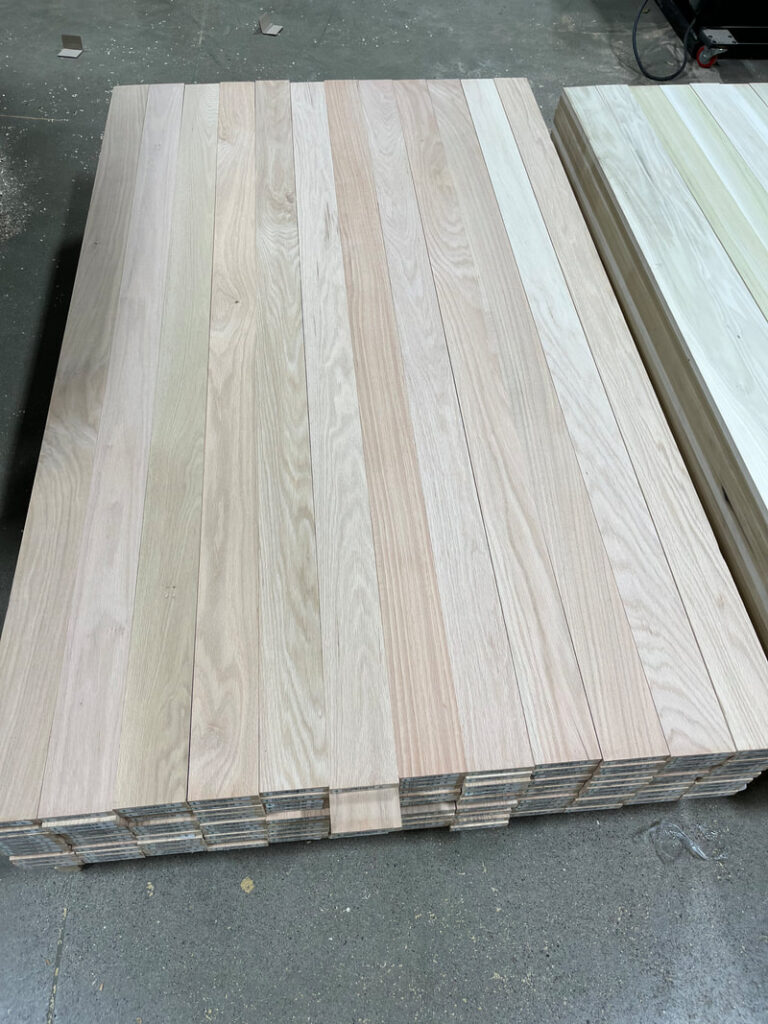
7' 1x8 Red Oak - $3.50/LF
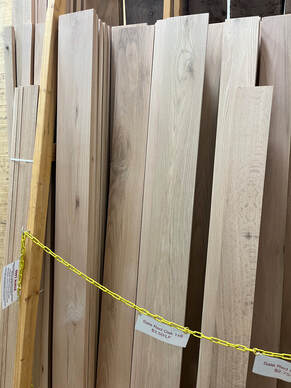
7' 1x6 Red Oak - $2.75/LF
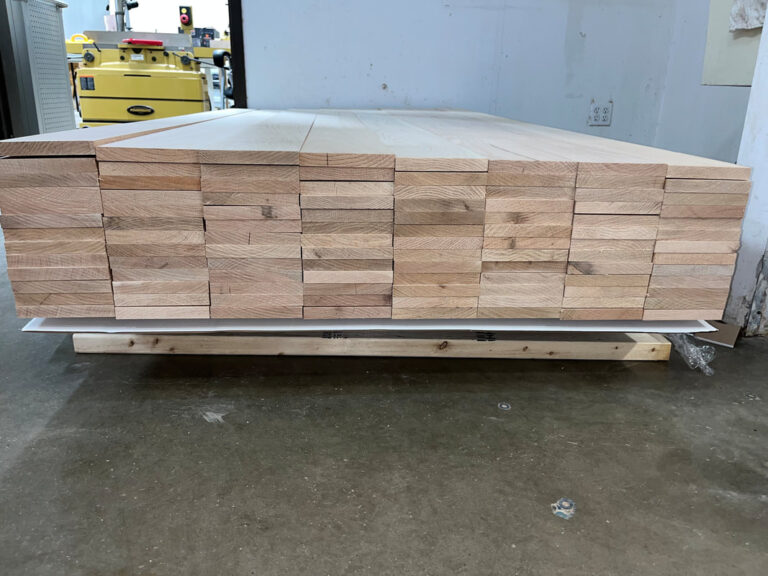
7' 1x4 Poplar $1.80/LF
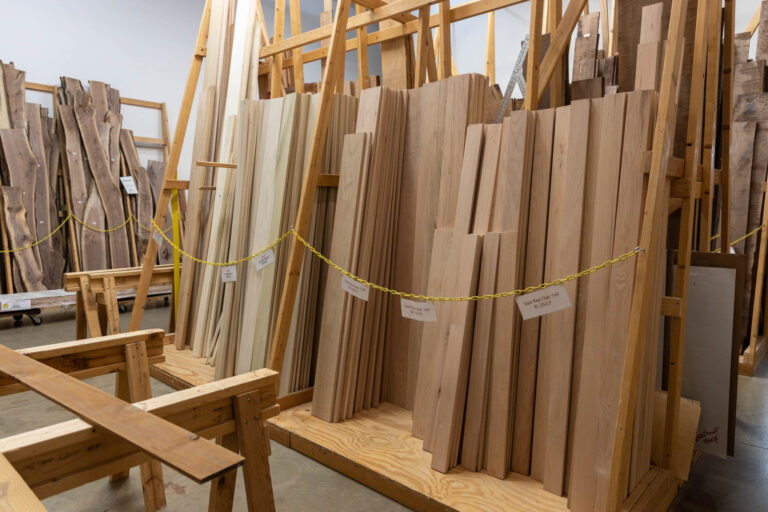
Find the Best Domestic Hardwoods for Your Project
Picking the right materials for your project is one of the most important decision of your build. Use our selection guide to help you decide on the right species of wood for your application. If you’re having trouble deciding, come by our store in Savage and we’ll help you find the right solution.
Alder
Alder is a lightweight, moderately soft hardwood native to the Pacific Northwest and commonly used across North America. Known for its workability, warm color, and ability to mimic more expensive woods, Alder is a versatile and budget-friendly option for a wide range of interior woodworking projects. Here’s a breakdown of its benefits and best use cases:
Benefits of Alder
Excellent Workability: Alder machines, sands, and finishes extremely well. It’s easy to cut and shape with both hand and power tools, making it ideal for precision work and detailed joinery.
Uniform Grain and Texture: With a fine, straight grain and smooth, consistent texture, Alder offers a clean, refined appearance that’s easy to stain or finish evenly.
Great for Staining: Alder readily accepts stains and dyes, often used to replicate the appearance of more expensive hardwoods like Cherry, Maple, or Walnut at a fraction of the cost.
Lightweight Yet Stable: It’s relatively lightweight, which makes it easier to handle and install, yet remains stable with minimal seasonal movement when properly dried.
Economical and Readily Available: As a fast-growing domestic species, Alder is affordable and widely accessible, making it a go-to choice for cost-conscious builders and woodworkers.
Best Use Cases for Alder
Cabinetry and Built-ins: Alder is a popular choice for kitchen cabinets, bathroom vanities, and built-in shelving due to its stainability, consistent appearance, and ease of customization.
Furniture: Frequently used for dressers, tables, beds, and case goods where a warm, natural look is desired without the cost of premium hardwoods.
Interior Doors and Trim: Perfect for panel doors, baseboards, crown molding, and window casing thanks to its smooth texture and clean finishing properties.
Veneers and Paneling: Used in veneer form for plywood, wall panels, and furniture where a high-end look is needed without the expense.
Paint-Grade Projects: Alder’s smooth grain makes it an excellent option for painted applications, offering a clean finish without requiring heavy grain filling.
Birch
Birch is a strong, light-colored hardwood commonly found throughout North America. Known for its smooth texture, subtle grain patterns, and dependable performance, Birch is a versatile choice for furniture, cabinetry, and architectural millwork. It offers a clean, modern look while remaining budget-friendly, making it a popular option across a range of interior applications. Here’s a breakdown of its benefits and best use cases:
Benefits of Birch
Light, Neutral Appearance: Birch ranges in color from pale cream to light reddish-brown, offering a soft, natural tone that fits well in both modern and traditional spaces.
Smooth, Fine Grain: With its even texture and subtle grain patterns, Birch provides a clean surface that accepts paint and stain evenly—making it highly adaptable for different finishes and styles.
Strong and Durable: Birch has a solid Janka hardness (around 1,260 for Yellow Birch), offering good resistance to everyday wear and tear while remaining easy to work with.
Cost-Effective: Birch is typically more affordable than premium hardwoods like Cherry or Walnut, delivering a great balance of appearance, strength, and value.
Readily Available: As a widely distributed domestic species, Birch is consistently available in multiple grades and dimensions, making it easy to source for both small and large projects.
Best Use Cases for Birch
Cabinetry and Casework: Birch is a go-to choice for kitchen cabinets, bathroom vanities, and built-ins thanks to its consistent grain and ability to take both clear and pigmented finishes.
Furniture Making: Commonly used for dressers, bookcases, tables, and chairs, Birch offers the durability and workability needed for everyday furniture.
Interior Trim and Doors: Ideal for molding, doors, and millwork in residential and commercial spaces where a clean, smooth surface is desired.
Paint-Grade Projects: Birch’s tight grain and smooth texture make it one of the best options for painted finishes—especially when a flawless, uniform surface is needed.
Plywood and Paneling: Frequently used as a core or face veneer in high-quality plywood, Birch is stable and attractive enough for both structural and visible applications.
Cherry
Cherry, also known as American Black Cherry (Prunus serotina), is a premium domestic hardwood cherished for its warm color, smooth grain, and graceful aging. It’s frequently used in fine furniture, cabinetry, and high-end interiors thanks to its rich appearance and reliable workability. Cherry continues to be a timeless favorite among woodworkers and designers who want elegance and long-term character. Here’s a breakdown of its benefits and best use cases:
Benefits of Cherry
Rich, Warm Color: Cherry begins with a light pinkish-brown tone and matures into a deep, reddish-brown patina over time. Its natural darkening process adds depth and character that only improves with age.
Smooth, Fine Grain: With a fine, straight grain and minimal texture, Cherry offers a refined surface that finishes beautifully. Its natural luster and consistent texture create a sleek, upscale look.
Excellent Workability: Cherry is easy to cut, sand, and shape. It machines cleanly and responds well to hand tools, making it a top choice for detailed joinery and precision work.
Moderate Hardness with Great Stability: With a Janka hardness around 950, Cherry is softer than woods like Oak or Maple but offers excellent dimensional stability. It resists warping and holds its shape well over time.
Graceful Aging: Few woods age as beautifully as Cherry. Exposure to light accelerates its color development, giving each piece a rich, natural story over time.
Best Use Cases for Cherry
Fine Furniture: Cherry is widely used for heirloom-quality pieces such as dining tables, bed frames, chairs, and case goods. Its natural beauty and aging characteristics make it perfect for long-lasting, custom-built furniture.
Cabinetry and Built-Ins: Ideal for kitchen cabinets, bathroom vanities, and wall units where a warm, elegant appearance is desired. Cherry finishes smoothly and can be left natural or lightly stained to enhance its depth.
Interior Trim and Millwork: Frequently used for baseboards, crown molding, wainscoting, and stair parts in upscale residential spaces due to its refined texture and premium appearance.
Architectural Paneling: Cherry panels add richness and warmth to libraries, offices, and formal living spaces. Its smooth finish and deepening tone create a timeless, cozy atmosphere.
Turned and Carved Projects: Cherry’s workability and smooth grain make it ideal for turned items such as bowls, spindles, or decorative moldings that require clean, crisp detail.
Hickory
Hickory is one of the hardest domestic hardwoods available, widely valued for its rugged durability, bold grain character, and rustic appeal. Whether used in flooring, furniture, or cabinetry, Hickory brings a strong visual presence and unmatched toughness. It’s especially popular in spaces where resilience and a natural, lived-in look are priorities. Here’s a breakdown of its benefits and best use cases:
Benefits of Hickory
Exceptional Hardness and Durability: With a Janka hardness rating of around 1,820, Hickory is one of the most durable hardwoods on the market. It stands up to heavy use, making it ideal for high-traffic or impact-prone areas.
Bold, Varied Appearance: Hickory features striking contrast between light and dark areas, often within the same board. This natural variation adds depth and visual texture, making every project unique.
Long-Term Strength: In addition to surface durability, Hickory is structurally strong, making it a reliable choice for pieces that need to hold weight or endure daily wear.
Distinct Grain Pattern: Its prominent grain gives Hickory a rustic, organic look that works especially well in traditional, farmhouse, or mountain lodge-style interiors.
Availability and Affordability: As a widely available domestic species, Hickory is typically cost-effective for its level of strength and visual character.
Best Use Cases for Hickory
Hardwood Flooring: One of the most popular choices for homes with kids, pets, or heavy foot traffic. Hickory’s hardness makes it highly resistant to denting, while its grain helps hide wear.
Rustic or Farmhouse-Style Furniture: Ideal for dining tables, benches, and storage pieces where bold grain and high durability are desired.
Cabinetry and Built-Ins: A great choice for kitchen cabinets, bathroom vanities, and mudroom storage—especially in designs that embrace natural wood tones and textures.
Stair Parts and Treads: Hickory’s strength and wear resistance make it excellent for staircases and landings that see daily use.
Architectural Millwork: Used for beams, paneling, mantels, and trim in rustic or craftsman-style homes where texture and strength are both priorities.
Hard Maple
Hard Maple, also known as Sugar Maple (Acer saccharum), is a dense, fine-grained hardwood native to North America. It’s prized for its strength, smooth texture, and clean, light appearance—making it a popular choice for high-traffic environments, precision furniture, and modern interiors. Its durability and consistent grain make it especially suitable for projects that require both function and refined aesthetics. Here’s a breakdown of its benefits and best use cases:
Benefits of Hard Maple
High Hardness and Strength: With a Janka hardness rating of around 1,450, Hard Maple is significantly tougher than many other domestic hardwoods. It resists dents, dings, and wear, making it ideal for surfaces that take daily abuse.
Smooth, Fine Grain: Hard Maple has a tight, consistent grain with very little texture. This gives it a sleek, contemporary appearance and makes it an excellent candidate for smooth finishes and precise machining.
Clean, Light Color: Naturally pale cream to light tan in color, sometimes with subtle mineral streaks, Hard Maple provides a bright, neutral look that fits well in modern and Scandinavian-style designs.
Excellent for Staining and Finishing: While Maple can be difficult to stain evenly due to its dense grain, it takes clear finishes and light-colored stains beautifully—enhancing its natural clarity and brightness.
Great Dimensional Stability: Once dried properly, Hard Maple holds its shape well with minimal movement over time. This makes it a reliable choice for cabinetry, flooring, and fine joinery.
Best Use Cases for Hard Maple
High-End Furniture: Frequently used in tables, dressers, desks, and shelving where a smooth surface and long-term strength are needed. Its clean look works well in both contemporary and transitional designs.
Hardwood Flooring: Ideal for busy households or commercial spaces, Hard Maple floors are highly resistant to wear and offer a sleek, modern look that holds up under pressure.
Cabinetry and Millwork: A favorite for kitchen cabinets, bathroom vanities, and interior trim where clean lines and uniform appearance are desired.
Butcher Blocks and Countertops: Due to its hardness and food-safe properties, Hard Maple is a top choice for kitchen work surfaces and cutting boards.
Musical Instruments and Sports Equipment: Used in piano actions, drum shells, bowling pins, and even baseball bats, thanks to its excellent strength-to-weight ratio and impact resistance.
Soft Maple
Soft Maple refers to several species of Maple—most commonly Silver Maple, Red Maple, Boxelder, and Bigleaf Maple—that are slightly less dense than Hard Maple but still offer great versatility and visual appeal. While not as hard as Sugar Maple, Soft Maple is durable, affordable, and finishes beautifully, making it a popular choice for furniture, cabinetry, and millwork. Here’s a breakdown of its benefits and best use cases:
Benefits of Soft Maple
Attractive, Subtle Grain: Soft Maple features a fine, even grain that is similar to Hard Maple, though sometimes slightly more varied. Its clean appearance makes it a good choice for projects that require a smooth, uniform finish.
Light, Neutral Color: Ranges from pale cream to light brown, sometimes with a pink or gray cast depending on the species. It serves as an excellent blank canvas for stains, paints, and custom finishes.
Easy to Work With: Softer than Hard Maple (with a Janka hardness between 700–1,000), Soft Maple is easier to cut, sand, and machine. It’s well-suited for hand tools and less demanding on blades and equipment.
Takes Stain and Paint Exceptionally Well: Unlike Hard Maple, Soft Maple is less prone to blotching, which makes it easier to achieve consistent results when staining or painting.
More Affordable Than Hard Maple: Soft Maple offers a similar aesthetic at a lower price point, making it a budget-friendly alternative for furniture and cabinetry.
Best Use Cases for Soft Maple
Furniture Making: Ideal for tables, chairs, beds, and storage pieces where a clean look and moderate durability are desired. It’s especially useful in painted or stained designs.
Cabinetry and Built-Ins: Used frequently in kitchen and bathroom cabinetry, Soft Maple’s ability to mimic more expensive species makes it a versatile choice for semi-custom and custom builds.
Interior Millwork: Perfect for trim, baseboards, crown molding, and paneling where a smooth finish and subtle grain are preferred.
Doors and Drawer Fronts: Commonly used in shaker-style and flat-panel doors where crisp edges and consistent finishes are important.
Paint-Grade Projects: One of the best hardwoods for painted applications thanks to its even grain, smooth surface, and reliable adhesion.
Red Oak
Red Oak is one of the most commonly used domestic hardwoods in North America, known for its strength, workability, and timeless appearance. With its warm tones and pronounced grain, Red Oak is a versatile option for a wide range of interior applications—from flooring and cabinetry to trim and furniture. Its affordability and wide availability make it a go-to choice for both traditional and modern designs. Here’s a breakdown of its benefits and best use cases:
Benefits of Red Oak
Classic, Familiar Appearance: Red Oak features a warm, reddish-brown base with a strong, open grain pattern that adds texture and character. It complements both traditional and transitional styles with ease.
Strong and Durable: With a Janka hardness rating of around 1,290, Red Oak offers solid performance for most residential applications. It holds up well under everyday wear and is less prone to denting than softer hardwoods.
Excellent Workability: Red Oak machines, sands, and finishes easily. It responds well to both hand tools and power equipment, making it a favorite among professional woodworkers and DIYers alike.
Highly Stainable: The open grain structure of Red Oak readily absorbs stains, allowing it to take on a wide variety of tones—from light natural to deep espresso—without losing its character.
Readily Available and Cost-Effective: As one of the most abundant hardwoods in North America, Red Oak is easy to source, budget-friendly, and available in a variety of grades and cuts.
Best Use Cases for Red Oak
Hardwood Flooring: A top choice for residential flooring due to its durability, stainability, and classic appearance. It’s especially popular in traditional and craftsman-style homes.
Furniture and Case Goods: Commonly used for dining tables, chairs, bookcases, and cabinets that require strength and a warm, inviting aesthetic.
Cabinetry and Built-Ins: Ideal for kitchen and bathroom cabinetry, Red Oak offers both durability and a grain that adds visual interest without overpowering the space.
Interior Trim and Molding: Frequently used for baseboards, window casing, and crown molding. Its workability and affordability make it perfect for large-scale millwork.
Stair Treads and Railings: Strong enough to handle heavy use, Red Oak is a reliable choice for stair components in both residential and commercial settings.
White Oak
White Oak is a premium domestic hardwood known for its strength, stability, and timeless aesthetic. With a closed grain, neutral tone, and superior moisture resistance, White Oak is widely used in flooring, furniture, and cabinetry—particularly in applications where both performance and refined style are essential. Its versatility makes it a favorite in everything from rustic to modern interiors. Here’s a breakdown of its benefits and best use cases:
Benefits of White Oak
Refined, Neutral Color: White Oak ranges from pale beige to light brown with subtle olive or gray undertones. Its neutral palette works beautifully with a variety of stains and finishes, making it extremely adaptable to different styles.
Tight, Closed Grain: Compared to Red Oak, White Oak has a smoother, more uniform appearance with less prominent grain texture. It offers a clean, elegant look with a softer visual presence.
Superior Durability: With a Janka hardness of around 1,360, White Oak is slightly harder than Red Oak and performs well in high-traffic and high-use environments.
Natural Moisture Resistance: Thanks to its closed cellular structure, White Oak is more water-resistant than most hardwoods, making it suitable for entryways, kitchens, and other areas where occasional moisture is a concern.
Excellent Workability and Finish Compatibility: White Oak machines well and takes both stains and clear finishes evenly. It responds beautifully to fuming, wire brushing, and cerused finishes for added texture and depth.
Ages Gracefully: Over time, White Oak develops a rich, golden patina that adds warmth and character to any space.
Best Use Cases for White Oak
Hardwood Flooring: One of the most popular and durable flooring options available. Its hardness and water resistance make it ideal for living rooms, hallways, and open-concept spaces.
Custom Furniture: Used in tables, desks, bed frames, and cabinets where strength, clean lines, and timeless style are priorities.
Cabinetry and Millwork: A top choice for kitchen and bathroom cabinets, wall paneling, and trim. White Oak’s smooth grain and stain versatility allow for a wide range of design expressions.
Staircases and Treads: Strong enough to withstand heavy foot traffic while providing an elegant, high-end look for stairs and landings.
Architectural Details: Frequently used for doors, ceiling beams, mantels, and built-ins in both residential and commercial interiors where longevity and visual appeal matter.
Poplar
Poplar is a lightweight, fast-growing hardwood native to North America, commonly used in utility-grade projects, paint-grade woodworking, and budget-conscious interiors. While not as hard or durable as other hardwoods, Poplar’s affordability, workability, and smooth finish make it an excellent choice for a wide range of interior applications—especially when a painted or stained finish is desired. Here’s a breakdown of its benefits and best use cases:
Benefits of Poplar
Smooth, Even Texture: Poplar has a fine, uniform grain with minimal knots or defects. Its consistent surface makes it ideal for painted finishes and applications where a clean look is needed.
Highly Workable: One of the easiest hardwoods to machine, Poplar cuts, sands, glues, and finishes with minimal effort. It’s a favorite among woodworkers for quick-turnaround projects or custom trim work.
Budget-Friendly: As one of the most affordable hardwoods available, Poplar is ideal for large-scale projects or applications where cost is a key consideration.
Takes Paint and Stain Well: Poplar is widely used in painted applications, but it can also be stained to mimic more expensive woods like Cherry or Walnut—though it may require a conditioner to prevent blotching.
Readily Available: Poplar is grown and harvested across the U.S., making it easy to source in a variety of dimensions and grades for everything from rough lumber to finished panels.
Best Use Cases for Poplar
Paint-Grade Millwork: A go-to choice for baseboards, crown molding, door casings, and window trim that will be painted. Its smooth texture eliminates the need for grain filling or heavy prep.
Interior Doors and Frames: Often used for solid core interior doors, jambs, and frames where paint is the final finish.
Cabinet Boxes and Drawer Components: Ideal for structural parts of cabinets that won’t be visible or will be painted. Poplar offers a good balance of stability and cost-effectiveness.
Built-Ins and Shelving: Used in closets, home offices, and custom shelving units where affordability and ease of finishing matter.
Furniture Frames and Painted Pieces: Commonly used for chair frames, table aprons, or other painted furniture components where structural strength and a clean finish are needed.
Walnut
Walnut, specifically American Black Walnut (Juglans nigra), is a highly prized hardwood known for its rich color, smooth grain, and timeless elegance. Revered in fine woodworking for centuries, Walnut delivers a premium look and feel across a wide range of interior applications. Whether used in furniture, cabinetry, or millwork, it brings warmth, sophistication, and lasting value. Here’s a breakdown of its benefits and best use cases:
Benefits of Walnut
Rich, Dark Color: Walnut ranges from deep chocolate brown to purplish-black with lighter sapwood accents. It has a natural elegance that enhances both classic and contemporary designs.
Beautiful Grain Character: With its generally straight grain and occasional curls, swirls, or figured patterns, Walnut offers a refined look that adds visual interest without being overly busy.
Excellent Workability: Walnut machines, carves, and finishes exceptionally well. It responds beautifully to hand tools and power equipment, making it a favorite for detailed joinery and custom craftsmanship.
Ages Gracefully: Walnut lightens slightly over time, developing a warm, golden undertone. This mellowing process adds to its character while maintaining its upscale appearance.
Moderate Hardness with Great Stability: With a Janka hardness of around 1,010, Walnut is softer than Oak or Maple, but it’s dimensionally stable and less prone to warping or movement once properly dried.
Takes Finish Beautifully: Walnut looks stunning with natural oil or clear finishes, which bring out its depth and luster without the need for stains.
Best Use Cases for Walnut
High-End Furniture: A top choice for dining tables, bed frames, desks, and cabinetry where luxury and craftsmanship are priorities.
Custom Cabinetry and Built-Ins: Ideal for kitchen islands, bathroom vanities, media units, and wall cabinetry where a premium aesthetic is desired.
Architectural Millwork: Commonly used for paneling, coffered ceilings, moldings, and stair parts in upscale residential and commercial interiors.
Flooring: While less common than other species due to cost and softness, Walnut is still used for premium flooring in low-traffic areas or where visual impact is key.
Turned and Carved Objects: Excellent for bowls, trays, sculpture, and high-end decorative pieces that benefit from Walnut’s smooth finish and dramatic color.
Basswood
Basswood, also known as American Linden (Tilia americana), is a soft, lightweight hardwood native to North America. While not suitable for structural applications, Basswood is prized for its fine, even grain and exceptional ease of carving and machining. It’s a top choice for detailed woodworking, painted projects, and applications where a smooth, clean finish is essential. Here’s a breakdown of its benefits and best use cases:
Benefits of Basswood
Lightweight and Easy to Handle: Basswood is very light in weight, making it ideal for projects that require easy maneuverability or low material weight—especially useful for hobbyists and artisans.
Exceptionally Easy to Work With: One of the softest hardwoods (Janka rating around 410), Basswood cuts, carves, glues, and sands with minimal resistance. It’s a favorite for hand tools and detailed shaping.
Fine, Uniform Grain: With its tight, closed grain and nearly texture-free surface, Basswood provides a clean, smooth finish that’s perfect for painted or stained applications.
Ideal for Painting and Staining: Although often used with paint, Basswood can also take light stains or dyes evenly. It doesn’t blotch easily, making it reliable for consistent color application.
Low Cost and Readily Available: As a fast-growing domestic species, Basswood is affordable and widely accessible in various sizes, including dimensional lumber, carving blocks, and sheets.
Best Use Cases for Basswood
Carving and Whittling: Widely regarded as one of the best woods for carving, Basswood is ideal for hand-carved figures, relief panels, and beginner wood carving projects.
Paint-Grade Millwork and Furniture: Frequently used in trim, moldings, small furniture parts, and cabinet doors where a smooth painted finish is the goal.
Musical Instruments: Often used in electric guitar bodies, piano keys, and other instrument components due to its light weight and acoustic properties.
Model Making and Prototypes: Perfect for architectural models, prototypes, and craft projects that require precise cuts and clean details.
Laser Cutting and CNC Work: Basswood’s softness and consistency make it an excellent material for laser engraving, CNC routing, and fine detail work in digital fabrication.
Explore Our Exotic Lumber Selection
Discount Lumber maintains the largest inventory of exotic hardwood in the Twin Cities. Our selection of exotic lumber includes:
- African Mahogany
- Black Limba
- Bloodwood
- Brazilian Cherry
- Granadillo
- Lacewood
- Padouk
- Zebrawood
- And Many More
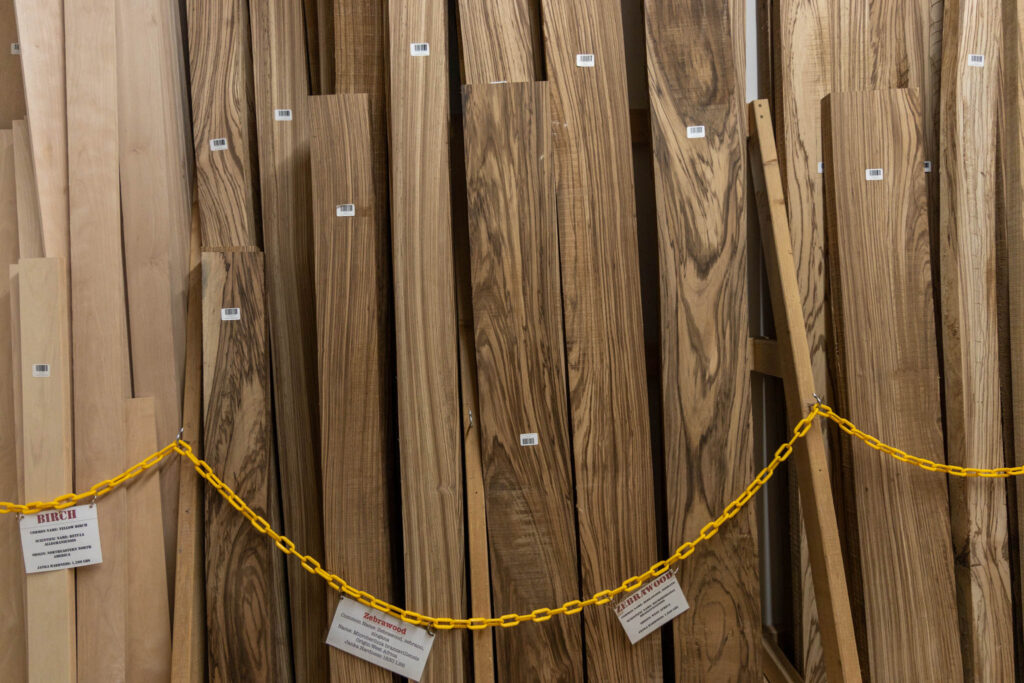
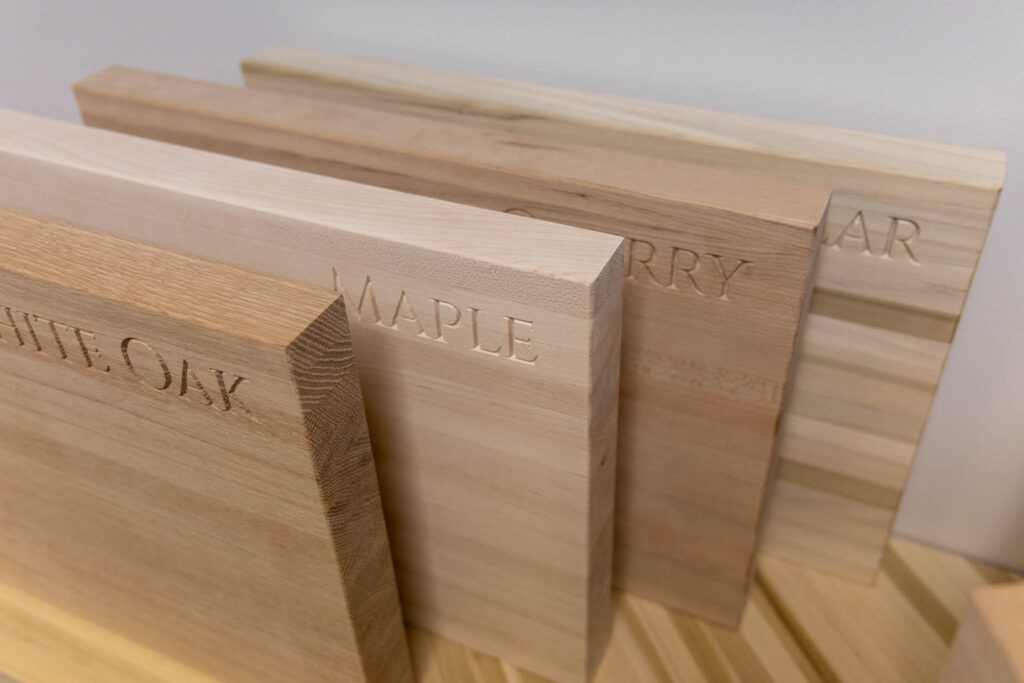
Build the Perfect Butcher Block Cutting Board
Discount Lumber readily stocks all of the materials you need to craft a beautiful butcher block cutting boards and countertops. Selections include:
- Oak
- Maple
- Walnut
- Hickory
- Cherry
- Poplar
- Red Grandis
- And More
Other DLO
Products
& Services
Hardwood
Flooring
Explore our selection of hardwood flooring! Whether you’re looking for traditional red oak, or something exotic, we have you covered.
Custom Moulding
Complement your home with beautiful custom moulding by Discount Lumber. Browse our complete selection here.
Butcher Block Cutting Boards & Countertops
Enjoy the timeless look and unmatched durability of butcher block cutting boards and countertops. Whether you plan to build it yourself or commission us to build it, our team is here to support you.
Sanding, Planing, & Custom Woodworking
Expand your woodworking capabilities with the help of our sanding, planing, and custom woodworking services. From flattening large slabs to sanding butcher block countertops, our team is here to help!
